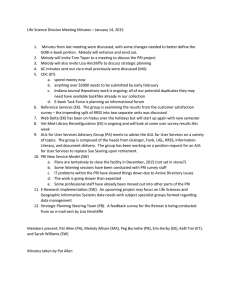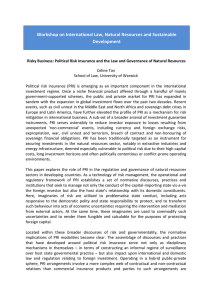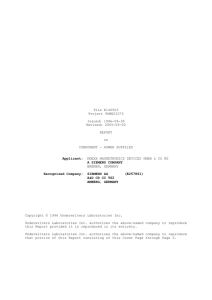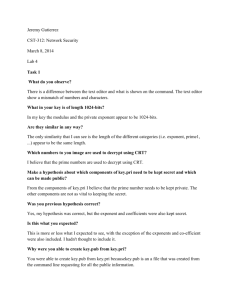Analysis of Random Pulse Repetition Interval Radar
advertisement
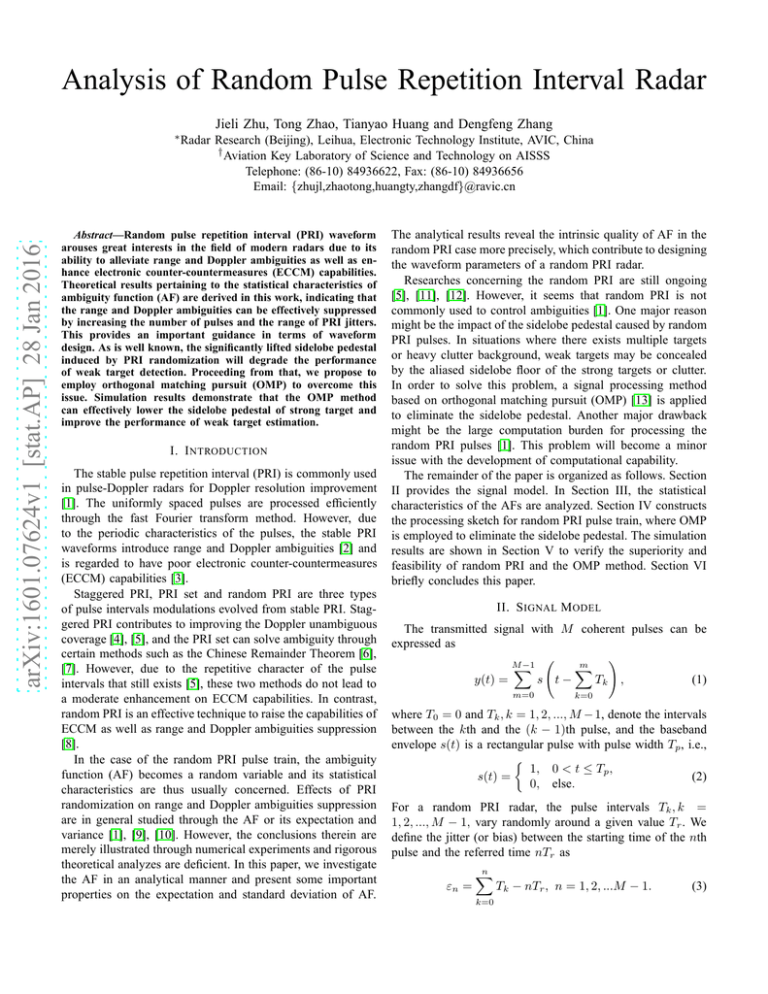
Analysis of Random Pulse Repetition Interval Radar
Jieli Zhu, Tong Zhao, Tianyao Huang and Dengfeng Zhang
arXiv:1601.07624v1 [stat.AP] 28 Jan 2016
∗ Radar
Research (Beijing), Leihua, Electronic Technology Institute, AVIC, China
† Aviation Key Laboratory of Science and Technology on AISSS
Telephone: (86-10) 84936622, Fax: (86-10) 84936656
Email: {zhujl,zhaotong,huangty,zhangdf}@ravic.cn
Abstract—Random pulse repetition interval (PRI) waveform
arouses great interests in the field of modern radars due to its
ability to alleviate range and Doppler ambiguities as well as enhance electronic counter-countermeasures (ECCM) capabilities.
Theoretical results pertaining to the statistical characteristics of
ambiguity function (AF) are derived in this work, indicating that
the range and Doppler ambiguities can be effectively suppressed
by increasing the number of pulses and the range of PRI jitters.
This provides an important guidance in terms of waveform
design. As is well known, the significantly lifted sidelobe pedestal
induced by PRI randomization will degrade the performance
of weak target detection. Proceeding from that, we propose to
employ orthogonal matching pursuit (OMP) to overcome this
issue. Simulation results demonstrate that the OMP method
can effectively lower the sidelobe pedestal of strong target and
improve the performance of weak target estimation.
I. I NTRODUCTION
The stable pulse repetition interval (PRI) is commonly used
in pulse-Doppler radars for Doppler resolution improvement
[1]. The uniformly spaced pulses are processed efficiently
through the fast Fourier transform method. However, due
to the periodic characteristics of the pulses, the stable PRI
waveforms introduce range and Doppler ambiguities [2] and
is regarded to have poor electronic counter-countermeasures
(ECCM) capabilities [3].
Staggered PRI, PRI set and random PRI are three types
of pulse intervals modulations evolved from stable PRI. Staggered PRI contributes to improving the Doppler unambiguous
coverage [4], [5], and the PRI set can solve ambiguity through
certain methods such as the Chinese Remainder Theorem [6],
[7]. However, due to the repetitive character of the pulse
intervals that still exists [5], these two methods do not lead to
a moderate enhancement on ECCM capabilities. In contrast,
random PRI is an effective technique to raise the capabilities of
ECCM as well as range and Doppler ambiguities suppression
[8].
In the case of the random PRI pulse train, the ambiguity
function (AF) becomes a random variable and its statistical
characteristics are thus usually concerned. Effects of PRI
randomization on range and Doppler ambiguities suppression
are in general studied through the AF or its expectation and
variance [1], [9], [10]. However, the conclusions therein are
merely illustrated through numerical experiments and rigorous
theoretical analyzes are deficient. In this paper, we investigate
the AF in an analytical manner and present some important
properties on the expectation and standard deviation of AF.
The analytical results reveal the intrinsic quality of AF in the
random PRI case more precisely, which contribute to designing
the waveform parameters of a random PRI radar.
Researches concerning the random PRI are still ongoing
[5], [11], [12]. However, it seems that random PRI is not
commonly used to control ambiguities [1]. One major reason
might be the impact of the sidelobe pedestal caused by random
PRI pulses. In situations where there exists multiple targets
or heavy clutter background, weak targets may be concealed
by the aliased sidelobe floor of the strong targets or clutter.
In order to solve this problem, a signal processing method
based on orthogonal matching pursuit (OMP) [13] is applied
to eliminate the sidelobe pedestal. Another major drawback
might be the large computation burden for processing the
random PRI pulses [1]. This problem will become a minor
issue with the development of computational capability.
The remainder of the paper is organized as follows. Section
II provides the signal model. In Section III, the statistical
characteristics of the AFs are analyzed. Section IV constructs
the processing sketch for random PRI pulse train, where OMP
is employed to eliminate the sidelobe pedestal. The simulation
results are shown in Section V to verify the superiority and
feasibility of random PRI and the OMP method. Section VI
briefly concludes this paper.
II. S IGNAL M ODEL
The transmitted signal with M coherent pulses can be
expressed as
!
M−1
m
X
X
(1)
y(t) =
s t−
Tk ,
m=0
k=0
where T0 = 0 and Tk , k = 1, 2, ..., M − 1, denote the intervals
between the kth and the (k − 1)th pulse, and the baseband
envelope s(t) is a rectangular pulse with pulse width Tp , i.e.,
1, 0 < t ≤ Tp ,
s(t) =
(2)
0, else.
For a random PRI radar, the pulse intervals Tk , k =
1, 2, ..., M − 1, vary randomly around a given value Tr . We
define the jitter (or bias) between the starting time of the nth
pulse and the referred time nTr as
εn =
n
X
k=0
Tk − nTr , n = 1, 2, ...M − 1.
(3)
1
0.8
0.8
0.6
0.6
AF
AF
1
0.4
0.4
0.2
0.2
0
0
1
2
3
4
0
0
5
Lemma 2 (Local monotonicity): E [|Λyy (τ, 0)|] (τ > 0)
is monotonically increasing on interval (cm , mTr ), and is
monotonically decreasing on interval (mTr , cm+1 ), where cm
is a constant within ((m − 1)Tr , mTr ), m = 1, 2, ..., M − 1.
Proposition 3 (Non-randomness of main lobe): The main
lobe of |Λyy (τ, 0)| does not vary randomly, i.e.,
1
2
(a) |Λxx (τ, 0)| and |Λyy (τ, 0)|
(b) |Λxx (0, f )| and |Λyy (0, f )|
Fig. 1. AFs of a stable PRI waveform (blue dashed) and a random PRI
waveform (red solid).
Assuming that the jitters εn , n = 1, 2, ...M − 1, are independent and identically distributed (i.i.d.) random variables
which are subject to an uniform distribution U(−ρ/2, ρ/2).
In avoidance of the interlacing over the successive pulses, the
range of jitters ρ is limited to ρ ≤ Tr − 2Tp . In the specific
case that ρ → 0, Tk equals a constant Tr . The transmitted
waveform then reduces to a stable PRI pulse train, i.e.,
x(t) =
M−1
X
m=0
s (t − mTr ) .
(4)
AF delineates the responses of matched filters and is usually
adopted to evaluate the range-Doppler estimation performance
of a waveform. A general form of AF [2] is defined as
Z +∞
Λuu (τ, f ) =
u(t)u∗ (t − τ )e−j2πf t dt.
(5)
−∞
Fig. 1 compares the AFs of a stable PRI waveform x(t)
with a random PRI waveform y(t). As shown in Fig. 1,
grating lobes appear [14] at τ = pTr and f = q/Tr ,
p, q = ±1, ±2, ..., ±(M − 1), in the AF of x(t), which are
range and Doppler ambiguities. For a random PRI pulse train,
owing to the randomness of the pulse intervals, the grating
lobes are lowered. However, the volume squeezed out of the
grating lobes is spreaded over the two-dimensional delayDoppler domain, which turns into the sidelobe pedestal.
III. S TATISTICAL C HARACTERISTICS
OF
|Λyy (τ, 0)| = |Λxx (τ, 0)|, 0 ≤ τ ≤ Tp .
3
f (1/Tr )
τ (Tr )
AF
The present section concerns the statistical characteristics
of the AF corresponding to the random PRI waveform. It is
a tedious work to directly manipulate the two-dimension AF
|Λyy (τ, f )|, and notice that |Λyy (τ, f )| ≤ |Λyy (τ, 0)| always
holds, hence the two main cross-sections are evaluated instead.
To be specific, we focus on the depiction of the expectation and
standard deviation of |Λyy (τ, 0)| and |Λyy (0, f )|, which reflect
the average level and fluctuation intensity of the sidelobes
in two directions, respectively. Due to limited space, all the
proofs are left to the subsequent journal paper.
Theorem 4 (Peaks of sidelobes): The values of normalized
AF G(τ ) := E [|Λyy (τ, 0)| / |Λyy (0, 0)|] (τ 6= 0) at local
maxima τ = pTr , p = ±1, ±2, ..., ±(M − 1), are given by
ρ
M − |p|
),
ρ < Tp ,
(1 −
M
3Tp
(7)
G(pTr ) =
Tp2
M − |p| Tp
(
− 2 ), ρ > Tp .
M
ρ
3ρ
Theorem 5 (Standard deviation of peaks): The standard deviation of |Λyy (pTr , 0)| / |Λyy (0, 0)|, p = ±1, ±2, ..., ±(M −
1) satisfies
s
p
M − |p| 2Tp
|Λyy (pTr , 0)|
≤
std
, ρ > Tp .
(8)
|Λyy (0, 0)|
M
3ρ
Remarks. For a stable PRI waveform, the grating lobes are
located at τ = pTr , p = ±1, ±2, ..., ±(M − 1), with relative
peak values (M −|p|)/M . Compared with the stable PRI case,
the range ambiguities of random PRI are suppressed and the
sidelobe pedestal is formed due to the dispersed volume of
grating lobes based on Lemma 2 and Theorem 4. It is also
known from Theorem 4 that the average range sidelobe level
depends on the range of jitters ρ, and becomes lower with
the increase of ρ. The variation of |Λyy (pTr , 0)| is subject to
the number of the pulses M as revealed
√ by Theorem 5, and
std [|Λyy (pTr , 0)| / |Λyy (0, 0)|] < 1/ M holds.
Theorems 4 and 5 are useful to guide the design of
waveform parameters for random PRI to achieve the desired
range sidelobe level. For instance, in order to achieve a
normalized range sidelobe level lower than 0.25, ρ = 5Tp
and M ≥ 54 can be chosen to ensure G(pTr ) < 0.2
and std [|Λyy (pTr , 0)| / |Λyy (0, 0)|] < 0.05, which implies
G(pTr ) + std [|Λyy (pTr , 0)| / |Λyy (0, 0)|] < 0.25. Then the
normalized range sidelobe level is less than 0.25 with a large
probability.
B. AF versus Reference Doppler
The expectation of the normalized AF versus reference
Doppler B(f ) := E [|Λyy (0, f )| / |Λyy (0, 0)|] can be expressed as
B(f ) =
E
A. AF versus Reference Delay
Lemma 1: E [|Λyy (τ, 0)|] is an even function with respect
to τ , i.e., E [|Λyy (τ, 0)|] = E [|Λyy (−τ, 0)|].
(6)
"
|sinc(πf Tp )|
×
M
(9)
#
M−1
21
X
X M−p−1
cos(2πf (pTr − εn+p + εn ))
M +2
.
p=1
n=0
The closed-form of (9) is hard to obtain; therefore, an upper
1/2
bound Bu (f ) = E |Λyy (0, f )|2
/|Λyy (0, 0)| and a lower
bound Bl (f ) = |E [Λyy (0, f )]| /|Λyy (0, 0)| are derived to
study the statistical characteristics of |Λyy (0, f )|.
Theorem 6 (Upper and lower bound): The upper bound and
lower bound of E [|Λyy (0, f )|/|Λyy (0, 0)|] are
Bu (f ) = |sinc(πf Tp )|×
(10)
!
! 21
2
sin(πM f Tr ) 1
− 1 sinc2 (πf ρ)
,
+ M
M sin(πf Tr ) M
|sinc(πf Tp )sinc(πf ρ)| sin(πM f Tr ) Bl (f ) =
×
. (11)
M
sin(πf Tr ) Theorem 7 (Peak of sidelobes): Denote E as the set of all
the nonzero local maxima for Bu (f ). Then, the maximum of
Bu (f ) on E is constrained as
r
1
1
+ (1 −
)sinc2 (πw),
(12)
max Bu (f ) <
f ∈E
M
M
where
(M − 1)ρ
,
w = min w∗ ,
M Tr
w∗ = inf w > 0 sinc2 (πw) = sinc2 (πw0 ) ,
(13)
(14)
and w0 is the maximum for sinc2 (πw) on interval w ∈ (1, 2).
Theorem 8 (Standard deviation): The standard deviation of
|Λyy (0, f )| / |Λyy (0, 0)| satisfies
s
|Λyy (0, f )|
1 − sinc2 (πf ρ)
≤
|sinc(πf Tp )|. (15)
std
|Λyy (0, 0)|
M
Corollary 9 (Non-randomness of main lobe): If M is sufficiently large, then the main lobe of |Λyy (0, f )| approximates
to the counterpart of |Λxx (0, f )|
|Λyy (0, f )|
|Λxx (0, f )|
1
E
≈
,
(16)
, |f | <
|Λyy (0, 0)|
|Λxx (0, 0)|
M Tr
|Λyy (0, f )|
1
std
≈ 0, |f | <
.
|Λyy (0, 0)|
M Tr
(17)
Remarks. Theorem 7 indicates that the amplitudes of
Doppler sidelobes and grate lobes can be lowered by increasing the number of pulse M and the range of jitters ρ.
Meanwhile, we can learn from Theorem 8 that the variation
of |Λyy (0, f )| decreases with increasing the number√of pulses
M and satisfies std [|Λyy (0, f )| / |Λyy (0, 0)|] < 1/ M .
Theorems 7 and 8 can be applied to design the waveform
parameters of random PRI to acquire the desired Doppler
sidelobe level. For instance, if a normalized Doppler sidelobe
level lower than 0.25 is required, then, M = 256 and
ρ ≥ 0.85Tr can be selected to ensure that the normalized
standard deviation std [|Λyy (0, f )| / |Λyy (0, 0)|] is less than
0.0625 and the maximum of Bu (f ) on E is lower than 0.18,
such that it obeys B(f )+std [|Λyy (0, f )| / |Λyy (0, 0)|] < 0.25
for |f | > 1/(M Tr ). Hence the requirement of Doppler
sidelobe level can be realized with a large probability.
IV. S IGNAL P ROCESSING
Matched filtering is a key ingredient in conventional radar
signal processing, where the signal-to-noise ratio (SNR) is
maximized. For a random PRI waveform, the pulses should be
aligned in range filtering and discrete Fourier transformation
(DFT) is applied to Doppler filtering. Based on the output
of matched filtering, the parameters of the targets can be
obtained through peaks detection. The aforementioned DFTbased moving target detection method is noted as DFT-MTD.
Recall that the random PRI waveforms can effectively suppress the range and Doppler ambiguities and enhance ECCM
capacities, which are the major predominances compared to
the stable PRI waveforms. However, the sidelobe pedestal
emerges due to the removed volume of grating lobes. The
weak targets could be concealed by the aliased sidelobe floor
of the strong targets or the heavy clutter if DFT-MTD is
adopted for processing random PRI waveforms. In order to
recover the echoes of weak targets, the impact of the strong
targets and the heavy clutter should be removed. OMP [13] is
an efficient compressed sensing algorithm, which successively
detects targets and eliminates the corresponding echoes. A key
step is to apply orthogonal projection filtering to thoroughly
remove the returns from the detected target, which can also
be found in [15], [16].
Assume that αk , τk and fk are the unknown amplitude, time
delay, and Doppler frequency of the kth target, respectively.
Sampled at a rate of 1/Ts , the contaminated echo from K
targets is given by
z(nTs ) =
K
X
k=1
αk y(nTs − τk )ej2πfk nTs + n0 (nTs ),
(18)
n = 0, 1, 2, ..., N − 1,
where n0 is a complex Gaussian white noise with a variance
of σ 2 and N is the number of samples. The received samples
can also be written in a form of matrix
z = Sa + n0 ,
(19)
where z = [z(0), z(Ts ), ..., z((N − 1)Ts )]T , a =
[α1 , α2 , ..., αK ]T , n0 = [n0 (0), n0 (Ts ), ..., n0 ((N − 1)Ts )]T ,
S
=
[s(τ1 , f1 ), s(τ2 , f2 ), ..., s(τK , fK )],
and
s(τk , fk ) = [y(−τk ), y(Ts − τk )ej2πfk Ts , ..., y((N −
1)Ts − τk )ej2πfk (N −1)Ts ]T , k = 1, 2, ..., K.
The detailed signal processing method is shown in Table I,
where the number of the targets can be estimated according to
references [17]–[19]. Compared with the DFT-MTD method,
the simultaneous detection and parameters estimation for all
targets is avoided. Instead, a series of detections and parameters estimations are performed, each of which corresponds to
a designated target. Consequently, the weak target detection
problem is solved.
V. N UMERICAL S IMULATIONS
A. Statistical Characteristics of AF
In this subsection, we present the impact of random jitters on the statical characteristics of AFs through numerical
TABLE I
S IGNAL P ROCESSING P ROCEDURES [13]
{τk ,fk }
(20)
(22)
−20
5
10
−5
−10
−15
−20
−25
0
15
5) k = k+1. If k exceeds the num of the targets, the signal is terminated,
otherwise return to 2).
0
0
−5
−10
−15
−20
5
10
−15
−20
−25
0
15
5
(d) ρ = 0.5Tr
0
−5
mean(AF) (dB)
0
−5
−10
−15
−20
−25
0
1
2
−10
−15
−20
−25
0
3
1
f (1/Tr )
2
3
2
3
f (1/Tr )
(a) ρ = 0
(b) ρ = 0.1Tr
0
0
−5
mean(AF) (dB)
experiments. The parameters are displayed in Table II. Fig.
2 and Fig. 3 illustrate the expectations of |Λyy (τ, 0)| and
|Λyy (0, f )| for different ranges of random jitters, respectively.
The calculations of expectations are provided by computer
simulation of 2000 independent Monte Carlo (MC) trials.
Fig. 2 shows the MC-based results of the normalized AF
versus reference time delay G(τ ) and the theoretical values
of (7). It can be observed that a small ρ leads to an effective
suppression of range grating lobes. Apart from that, the effect
of random PRI on range ambiguities suppression is better with
a larger range of jitters ρ. When ρ approaches Tr , the volume
of the grating lobes is spreaded over almost everywhere in
the delay domain. All the aforementioned results are in good
agreement with the conclusions in Lemma 2 and Theorem 4.
The normalized AF versus reference Doppler B(f ) and its
upper and lower bounds are shown in Fig. 3. We notice that the
upper and lower bounds proposed in Section III-B are useful.
It can be seen from Fig. 3 that the Doppler grating lobes of
random PRI are lower than the counterparts of stable PRI, and
they can be significantly suppressed with a large ρ. However,
the effect of small range of jitters ρ is unapparent. We note
that levels of grating lobes depend on the number of pulses
M as well.
As observed from Figs. 2 and 3, for the case that M = 32, in
order to obtain a satisfactory suppression (lower than −5dB)
of range and Doppler ambiguities simultaneously, a large ρ
(e.g., ρ = 0.9Tr ) can be adopted in random PRI waveform
15
Fig. 2. Simulation results of E [|Λyy (τ, 0)|/|Λyy (0, 0)|] (blue solid) and
the theoretical values of (7) (red cross).
mean(AF) (dB)
Value
10GHz
32
1us
50us
1MHz
10
τ (Tr )
(c) ρ = 0.5Tr
mean(AF) (dB)
Parameter
Carrier Frequency / f0
Pulse Number / M
Pulse Width / Tp
PRI / Tr
Sampling Frequency / Fs
15
−10
τ (T r)
TABLE II
R ADAR WAVEFORM PARAMETERS
10
(b) ρ = 0.1Tr
−5
−25
0
5
τ (T r)
(a) ρ = 0
mean(AF) (dB)
⊥
z (k) = PA
z.
−15
τ (Tr )
(21)
where A = [s(τ̂1 , fˆ1 ), s(τ̂2 , fˆ2 ), ..., s(τ̂k , fˆk )].
4) Apply orthogonal projection filtering to data z
−10
−25
0
where (·)H denotes the conjugate transpose operation.
3) Reconstruct the steering vector of the kth detected target as s(τ̂k , fˆk ).
The orthogonal projection matrix is updated
⊥
PA
= I − A(AH A)−1 AH ,
mean(AF) (dB)
{τˆk , fˆk } = arg max {|sH (τk , fk )z (k−1) |},
0
mean(AF) (dB)
1) k = 1, z (0) = z.
2) Apply matched filtering to data z (k−1) , then the estimated parameters
of the kth target {τˆk , fˆk } are obtained through peak detection,i.e.,
mean(AF) (dB)
0
−5
−10
−15
−20
−25
0
1
2
f (1/T r )
(c) ρ = 0.5Tr
3
−5
−10
−15
−20
−25
0
1
f (1/T r )
(d) ρ = 0.9Tr
Fig. 3. Simulation results of E [|Λyy (0, f )|/|Λyy (0, 0)] (blue solid), its
upper bound (red dashed) and lower bound (magenta dotted).
designing.
B. Weak Target Recovery
In this subsection, MC simulations are employed to evaluate
the performance of the OMP method on weak target signal
recovery, and we also involve DFT-MTD for comparison.
Consider a random PRI pulse train consisting of M = 256
pulses. The range of random jitters ρ = 0.8Tr and the rest
parameters are identical to Table II.
Suppose that the received signal is composed of a strong
target (T1 ) and a weak target (T2 ). The ranges and Doppler
1
0.8
0.8
0.6
0.6
Pr
Pr
1
0.4
0.2
fades as the power of T1 gets larger, and it almost fails to
recover the weak target T2 when SNR1 is 16 dB higher than
SNR2 , since the sidelobe pedestal of T1 is not eliminated by
DFT-MTD when T2 is concealed in it.
0.4
T1 −DFT−MTD
T2 −OMP
T2 −DFT−MTD
0
−14 −12 −10 −8 −6
SNR k (dB)
(a) σ2 varies
−4
0.2
0
6
VI. CONCLUSION
T2−OMP
T2−DFT−MTD
8
10 12 14 16
SNR 1 / SNR 2 (dB)
18
(b) |α1 |2 varies
Fig. 4. (a) Pr versus SNRk , k = 1, 2. For the sake of comparison between
T1 -DFT-MTD and T2 -OMP, the abscissa are SNR1 for the curve T1 -DFTMTD and SNR2 for the curves T2 -OMP and T2 -DFT-MTD, respectively. (b)
Pr versus SNR1 /SNR2 .
frequencies of T1 and T2 are {R1 , f1 } = {11.98km, 40kHz}
and {R2 , f2 } = {15.05km, 30kHz}, respectively. The SNR
of Tk is defined as SNRk = |αk |2 /σ 2 , k = 1, 2. The range
resolution and Doppler frequency
resolution are defined as
PM−1
∆R = c/(2Fs ) and ∆f = 1/ 0
Tk , respectively. For a
designated target, signal recovery is considered a success if
the estimation errors of its range and Doppler frequency are
less than ∆R/2 and ∆f /2, respectively. The probability of
successful recovery Pr is utilized as a metric of algorithm
performance.
So as to illustrate the performances of the aforementioned
two methods on weak target recovery, the following two
different scenarios are employed for simulations. Within each
scenario, 500 independent MC trials are conducted.
Scenario (a): both |α1 | and |α2 | are fixed and |α1 |2 /|α2 |2 =
10dB, while the power of the noise σ 2 varies. Under such
a scenario, which is designed for demonstrating the impact
of noise, the average performances of the two methods are
shown in Fig. 4a. In order to compare the performances on the
strong and the weak target under the same SNR rather than the
same σ 2 , the results of T1 and T2 are depicted with respect
to SNR1 and SNR2 , respectively. Since the performance of
OMP is consistent with that of DFT-MTD on T1 , the curve T1 OMP is omitted from the figure. Benefited from the orthogonal
projecting procedure, which wipes out the impact of the strong
target, the OMP method outperforms DFT-MTD on the the
weak target (i.e. T2 ) recovery. In addition, it is satisfying that
the performance of OMP for weak target recovery is almost
the same as that of DFT-MTD for strong target recovery,
indicating that in terms of weak target recovery, the strong
target produces trivial impact on the performance of OMP
under the present scenario.
Scenario (b): only |α1 | varies, whereas |α2 | and σ 2 remain
constant and SNR2 = −6dB holds. Since SNR2 is fixed, the
impact of the strong target T1 on the performances of the
two methods is explicitly revealed; see Fig. 4b. The OMP
method could successfully recover the weak target, even when
the power of T1 is 18dB higher than that of T2 , in respect that
the echo from T1 is removed from the received samples and
thus T2 is not masked in the aliased sidelobe of T1 . On the
contrary, however, the performance of DFT-MTD gradually
In this paper, we analyzed the statistical characteristics
of the AF of random PRI waveforms. Effects of ambiguity
suppression were analyzed through theoretical derivation and
illustrated by simulations. The theoretical results of the expectation and standard deviation of the AFs were crucial for the
waveform design. OMP method was applied to deal with the
problem that the weak targets might be submerged in the high
pedestal of the strong target/clutter. Simulation results verified
the feasibility of the OMP method.
R EFERENCES
[1] S. B. Rasool and M. R. Bell, “Efficient pulse-doppler processing and
ambiguity functions of nonuniform coherent pulse trains,” in Radar
Conference. IEEE, 2010, pp. 1150–1155.
[2] N. Levanon and E. Mozeson, Radar Signals. NewYork, USA: Wiley,
2004.
[3] M. I. Skolnik, Radar Handbook.
NewYork, USA: McGraw-Hill
Professiona, 2008.
[4] H. W. Thomas and T. M. Abram, “Stagger period selection for moving
target radars,” Procedings of the Institution of Electrical Engineers, vol.
123, no. 3, pp. 195–199, March 1976.
[5] N. Levanon and E. Mozeson, “Analysis of the digital MTI filter with
random PRI,” Radar and Signal Processing, IEE Procedings F, vol. 140,
no. 2, pp. 129–137, April 1993.
[6] S. Hovanessian, “Medium PRF performance analysis,” IEEE Trans.
Aerospace and Electronic Systems, vol. 18, no. 3, pp. 286–296, May
1982.
[7] S. Ahn, H. Lee, and B. Jung, “Medium PRF set selection for pulsed
doppler radars using simulated annealing,” in Radar Conference. IEEE,
2011, pp. 90–94.
[8] F. Neri, Introduction to Electronic Defense Systems. Boston, London:
Artech House, 2001.
[9] M. Kaveh and G. R. Cooper, “Average ambiguity function for a randomly staggered pulse sequence,” IEEE Trans. Aerospace and Electronic
Systems, vol. 12, no. 3, pp. 410–413, May 1976.
[10] Z. Liu, X. Z. Wei, and X. Li, “CS-based moving target detection in
random pri radar,” in Proceedings Int. Geosci. Remote Sens. Symp.
IEEE, 2012, pp. 7476–7479.
[11] ——, “Aliasing-free moving target detection in random pulse repetition
interval radar based on compressed sensing,” IEEE Sensors Journal,
vol. 13, no. 7, pp. 2523–2534, April 2013.
[12] Q. Chen, J. H. Liu, C. W. Fu, and H. T. Wang, “Performance analysis and
side lobe suppression in radonFourier transform based on random pulse
repetition interval,” Computer Modeling & New Technologies, vol. 18,
no. 11, pp. 48–54, June 2014.
[13] J. A. Tropp and A. C. Gilbert, “Signal recovery from random measurements via orthoganal matching pursuit,” IEEE Trans. on Information
Theory, vol. 53, no. 12, pp. 4655–4666, December 2007.
[14] B. R. Mahafza and A. Z. Elsherbeni, MATLAB Simulations for Radar
Systems Design. USA: Chapman & Hall/CRC, 2004.
[15] X. D. Zhang, Matrix Analysis and Applications.
Beijing, China:
Tsinghua University Press & Springer, 2004.
[16] Y. M. Liu, H. D. Meng, G. Li, and X. Q. Wang, “Range-velocity
estimation of multiple targets in randomised stepped-frequency radar,”
Electronics Letters, vol. 44, no. 17, pp. 1032–1034, August 2008.
[17] G. Schwarz, “Estimating the dimension of a model,” Ann. Statist., vol. 6,
no. 2, pp. 461–464, 1978.
[18] R. Schmidt, “Multiple emitter location and signal parameter estimation,”
IEEE Trans. Antennas and Propagation, vol. 34, no. 3, pp. 276–280,
March 1986.
[19] H. Wu, J. Yang, and F. Chen, “Source number estimators using transformed gerschgorin radii,” IEEE Trans. Signal Processing, vol. 43, no. 6,
pp. 1325–1333, June 1995.

